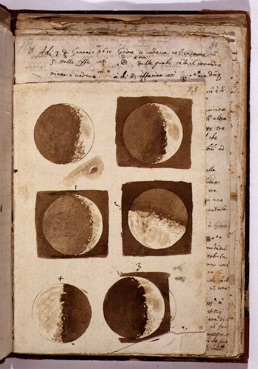untitled observations spacetime (2001 - 2007) investigates nuances of seeing and knowing through the process of collecting images, thoughts and experiences in the wake of “911” (Note 1). Exhibited in the form of panoramas and singularly focused still and video works at sites on Eastern Long Island where the landscape is a picture of Manhattan (Note 2) a century ago.
Representing the natural history of everyday life in which notions of beauty, art, science and myth are investigated. Such as how images produced by technology - the camera and telescope - mirroring our world evoke profoundly different ideas than pictorial representations made by hand from memory. Sandrow’s process mirrors the practice of Paduan Galileo Galilei (Note 3) use of a camera obscura to project telescopic images that he traced on paper (pictured, l, from Sidereus Nuncius). A method that led to his challenging 2000 years of Aristotelian thinking: discovery of the moon’s rocky surface. A contemporary influence and inspiration for Sandrow’s work is Nancy Holt: an artist who’s work, including Holes of Light and Locators, “provided a new lens for observing natural phenomena”. (Note 4)
Viewing primary elements of the visible world places observations and beliefs in specific cultural (matriarchy or patriarchy) and science-based contexts; time frames of lunar or solar calendars. Live streams position viewers memories as having been “firsthand” as shown in the collective experience of “911”. “Looking to the skies” to foretell a lunar eclipse is now “looking online” at NASA “Index To Five Millennium Catalog of Lunar Eclipses”. “Mapping” has new meaning (Note 5) when applied to global technology as this information revolution profoundly affects the world in all dimensions.
copyright © 2021 Hope Sandrow all rights reserved
Note 1: The morning of 911, Sandrow was in Washington DC at the Corcoran Gallery of Art, across from the White House, for the opening reception of the national tour of her installation time(space) in the exhibit Response to Place.
Note 2: Sandrow lived and worked in her Manhattan studios 1975 - 2006, where her series Water Life (1998) similarly juxtaposed the natural world of Manhattan to Eastern Long Island while living part time in Shinnecock Hills 1976 - 2006.
Note 3: The white cockeral who’s path crossed with Sandrow (March 2006) in the woods, a Chance Encounter, is a Paduan (English) aka Padovana (Italian) as was Galileo.
Note 4: https://www.diaart.org/visit/visit-our-locations-sites/nancy-holt-sun-tunnels
Note 5: (2005) Illustrated in the public reading/performance of Poe’s Eureka (commencing 3:00pm May 21 2005); documented in Observational Findings Mt. Vernon Park spacetime commissioned by (then) Contemporary Museum Director Thom Collins.

